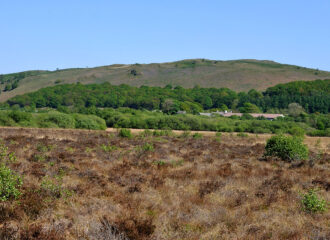This section covers the heath and bog habitats in Wales, all of which are considered to be under threat and listed in Annex I of the EC Habitats Directive. There tends to be a lot of overlap between the dominant species in these habitats, making the habitats potentially difficult to differentiate, particularly in transitional states. Furthermore, the substrate can be the key determinant between heaths and mires, with raised bogs and blanket bogs always found on deep peat, i.e. peat more than a metre deep.
Heaths and mires

Heaths
Five types of heath are covered here: European dry heath, bilberry heath, maritime heath, humid heath, and wet heath. These heaths and, where relevant, their modified states are described in the sections under the headings below. A sixth type, dune heath, is covered in the section on ‘Coastal dunes’.

Mires
There are five broad ‘mire’ types in Wales: raised bog, blanket bog, floodplain valley mire, transition mire and marshy grassland. The first two of these are described in the sections below, with reference states and modified states described where relevant. Valley mires and transition mires are described in the section on ‘Fens and swamps’, and…

